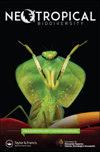生活在亚马逊泛滥平原溪流中的雄性矮凯门鳄(Paleosuchus palpebrosus和Paleosucus triangatus)的生活范围和运动模式
IF 0.8
Q4 ECOLOGY
引用次数: 1
摘要
侏儒凯门鳄(短吻鳄科:palpebrosus古鳄鱼和trigonatus古鳄鱼)是一种小型鳄鱼,在亚马逊地区普遍存在,表现出隐蔽的行为和复杂的栖息地利用。我们的目标是评估个体的家园范围,栖息地占用和运动模式,它们发生在同属的地方,与季节水位变化有关。我们利用VHS无线电发射机沿着两条直接受普鲁斯河洪水脉冲影响的溪流的海岸追踪了5条palpebrosus和7条p.t trigonatus。与三角鱼相比,palpebrosus个体的日移动距离更大,活动范围更广,对水位升高的反应也不同。palpebrosus进入了洪水泛滥的森林,它们的主要猎物也是如此。相反,体型较大的三角鱼个体通常停留在主流附近,并且相对定居。种内范围重叠高于种间重叠。因此,作为水位变化函数的栖息地占用模式可能促进两种矮凯门鳄在同一地点的共存。研究结果表明,在季节性洪水条件下,古龙物种在同栖环境中表现出一定程度的栖息地划分,表现为不同的日迁移率、栖息地大小和栖息地位置。本文章由计算机程序翻译,如有差异,请以英文原文为准。
Home range and movement patterns of male dwarf caimans (Paleosuchus palpebrosus and Paleosuchus trigonatus) living in sympatry in Amazonian floodplain streams
ABSTRACT Dwarf caimans (Alligatoridae: Paleosuchus palpebrosus and Paleosuchus trigonatus), are small crocodilians exhibiting cryptic behaviour and complex habitat use that occur throughout the Amazon region. Our goals were to evaluate individual home range, habitat occupancy and movement patterns where they occur in sympatry in relation to seasonal water-level variation. We tracked five P. palpebrosus and seven P. trigonatus using VHS radio transmitters along the shores of two streams directly influenced by the flooding pulse of the Purus River. Paleosuchus palpebrosus individuals moved greater distances on a daily basis and had larger home ranges than P. trigonatus, and the species had different responses to increases in water levels. Paleosuchus palpebrosus moved into flooded forests, as do their principle prey species. Conversely, larger P. trigonatus individuals usually remained near the main stream, and were relatively sedentary. Intraspecific home-range overlap was higher than interspecific overlap in both species. Thus, habitat occupancy patterns as a function of water-level variation might facilitate coexistence of the two species of dwarf caimans in the same location. This study shows that when living in sympatry under a seasonal flooding regime, Paleosuchus species show a degree of habitat partitioning evidenced by different daily movement rates, home-range sizes and home-range locations.
求助全文
通过发布文献求助,成功后即可免费获取论文全文。
去求助
来源期刊

Neotropical Biodiversity
Environmental Science-Ecology
CiteScore
1.80
自引率
0.00%
发文量
39
审稿时长
24 weeks
 求助内容:
求助内容: 应助结果提醒方式:
应助结果提醒方式:


